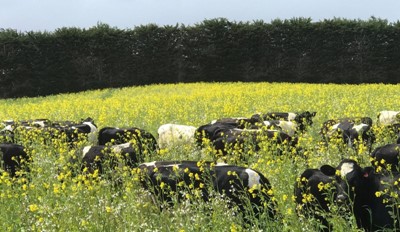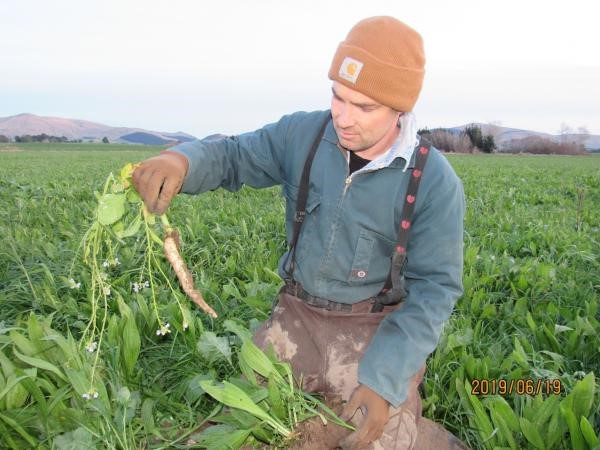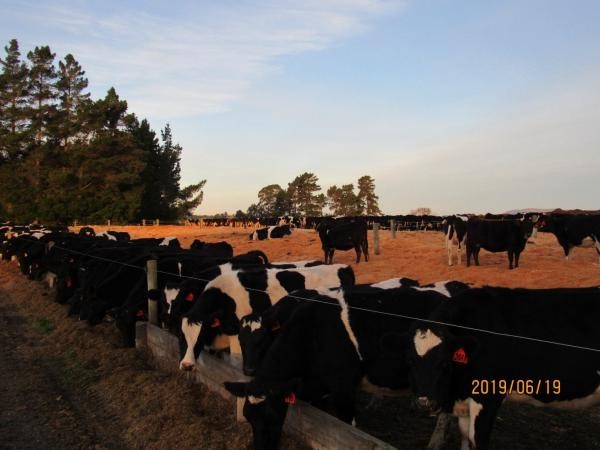Science has come charging to the rescue of regenerative agriculture in NZ.

In South Otago having no bare soil is a challenge in the winter.
Mark and Madeline Anderson are trialing alternatives to wintering on fodder beet to avoid mud and the costly animal health issues that can come with it.
Mark proudly showed me the clear flowing streams on his dairy farm last week.
By guest writer Siobhain Griffin of next.level.grazing@gmail.com
Mark is experimenting with bale grazing his 620 cows in four separate mobs on permanent pasture instead of winter crop. He says, "Bale grazing is the only wintering program that has future benefits, even more so than multispecies cropping." It is working better on paddocks with higher covers because of the deeper root mat. He doesn't use bale feeding rings and shifts the cows before they have decked the paddock.

Mark and Vova, his herdsman, grazed one group of 100 cows on 4.5 Ha for 30 days on 3-day shifts. Another two mobs have been on 14 Ha for 20 days so far on daily shifts. His main emphasis is to protect the ground, so he feeds extra bales above maintenance and some hay gets left behind because stock are shifted before they damage the paddock.
When I asked Mark if he worries about the uneaten hay, he reveals his careful attention to both the land and good stockmanship. "It is not like there would be no feed waste if I were feeding fodder beet. And soil loss can be a significant waste in a winter brassica crop scenario. If there was a price on that, farmers would think about other options to keep the soil covered. Topsoil and nutrient loss is a negative waste. Any hay my cows tread into the ground is a positive because it feeds the soil biology and worms that improve my soil fertility. The cows are very settled and content. The area is generally clean, and they can sit down and rest. When I shift them, I can check out each cow for any health problems as they walk by. With bale grazing I am trying to build up that water holding capacity for the future.
Increasing the carbon in the soil is a double gain really, I will get better water holding capacity in my soil for summer and healthy soil will drain better in winter. There should be 65% air space in healthy soil." Winter brassica crop feeding can destroy that soil structure.
Like Dean Martin in our Part 1 case study last time, Mark has studied up the soil science behind plant diversity from scientists like Christine Jones and Nicole Masters, and agricultural research trials run by the Rodale Institute and the Jena experiments in Germany and acknowledges the positive effects plant diversity has on soil fertility.
To put this knowledge to work on his farm Mark is planting 12-14 pasture species in his permanent pastures including prairie grass, cocksfoot, timothy, red clover, white clover, perennial rye grass, plantain, pasture brome and chicory. Simon Walker from Advance Agriculture put together the mix and said I think the most important thing Mark does well is he is prepared to listen to ideas and go home and evaluate them in a practical way."
When asked if he tops paddocks Mark says "No topping or mowing. Mowing is fine on the ryegrass treadmill. It is better to grow taller more diverse grass and not top or mow. "
The Andersons have built four uncovered wintering pads to protect soil in wet weather. Each pad cost about $20,000 for drainage and a collecting pond to protect the river plus another $20,000 for rocking and contractors. On top of the rock they place one meter of wood chips and this is topped with 30 cm of sawdust. The top layer is scraped clean every two to three weeks. Mark thinks the cows are healthiest being outdoors so long as they are not in the mud. Not all the cows can be housed on the wintering pads and the bale grazing will save money by reducing some of the need for the pad which costs $18-$20 per cow per week to operate including silage, bedding, labor and spreading costs associated with slurry and bedding.

Another Anderson on-farm trial involves 50 Ha of multi-species winter crops. He has no mono-crop fodder beet this year. To limit soil disturbance, Mark sprays the paddocks mid-December before seeding and direct drills species including sunflower, kale, plantain, oats, and daikon radish which sends a compaction smashing tap root down as deep as 40 cm.
The multi species crop struggled for lack of water in the region over the summer and Mark is grazing the winter crop with his remaining cows. He is careful not to keep them on long enough to cause soil damage and the grasses included in the mix help protect the soil from hoof damage.
He says "I could certainly wreck these paddocks of multispecies if I fed out on them" so bale feeding is only being done on the older pastures on the support block which need extra fertility. Mark plans to expand the bale feeding to part of the milking block next year starting with the paddocks which most need improvement.
I asked Mark how important the five principles of regenerative farming that Gabe Brown investigates in his book "Dirt to Soil"? He corrects me "Oh there are six principles now in the rapidly evolving field of regenerative agriculture including 'looking at your farm in context'." To Mark this means, "Of course I have a business to run but I still have to be mindful that I am looking after the ecology of the whole system."
For further information on regenerative farming - for farmers who want to learn more, go on Facebook and look for these regenerative farming pages:
Or go to websites like:
Thank you Siobhain at next.level.grazing@gmail.com for another interesting look at regenerative farming in practice.
Keep asking great questions ...